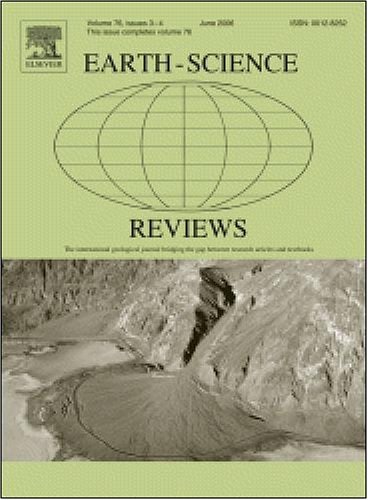Stabilisation and destabilisation of coastal blue carbon: The key factors
IF 10
1区 地球科学
Q1 GEOSCIENCES, MULTIDISCIPLINARY
引用次数: 0
Abstract
Blue carbon ecosystems (BCEs), which include seagrass meadows, tidal marshes and mangrove and supratidal forests, hold large reservoirs of organic carbon. Despite the impact of BCEs as natural climate solutions, the mechanisms responsible for carbon retention have not been clearly summarised, limiting our chance to manage BCEs for maximum carbon storage. Here, we explore a great mystery of the blue carbon cycle by reviewing existing published literature: Why is some coastal carbon remineralised into CO2 and CH4 by microbes within seconds/min while other carbon escapes microbial attack and becomes sequestered for millennia? The answer to this question will help predict and manage the global blue carbon cycle. We find that microbial communities are fundamental drivers of carbon mineralisation in BCE sediments, with their metabolic pathways dictating the fate of sequestered organic matter. Contrary to earlier notions, microbial diversity and composition are shown to significantly impact carbon stabilisation, with distinct microbial taxa targeting different organic compounds. Furthermore, anthropogenic disturbances such as habitat alteration and eutrophication can disrupt microbial communities, leading to increased carbon mineralisation and CO2 and CH4 emissions. Environmental parameters such as temperature, salinity, and nutrient availability also exert considerable influence on carbon stability in BCEs. Changes in these factors can alter microbial activity and the degradation rate of organic matter, highlighting the importance of understanding their additive and synergistic effects. For instance, warming combined with oxygen exposure due to habitat disturbance can amplify microbial carbon mineralisation, particularly in submerged BCEs like seagrass beds. Future research directions include characterising carbon at molecular levels, understanding region-specific drivers of carbon stability, and prioritising conservation efforts based on physiographic and geomorphologic settings. This review underscores the need for a holistic approach to BCE management, considering both microbial processes and environmental factors. By elucidating the factors governing carbon stability, this study aims to enhance our understanding of the role of BCEs in climate change mitigation and inform conservation strategies.
沿海蓝碳的稳定与不稳定:关键因素
蓝碳生态系统(bce)包括海草草甸、潮汐沼泽、红树林和潮上森林,拥有大量的有机碳储存库。尽管生物燃料作为自然气候解决方案具有一定的影响,但碳保留的机制尚未得到明确总结,这限制了我们管理生物燃料以最大限度地储存碳的机会。在这里,我们通过回顾现有已发表的文献来探索蓝碳循环的一个巨大谜团:为什么一些沿海碳在几秒/分钟内被微生物重新矿化成二氧化碳和甲烷,而其他碳逃脱微生物的攻击并被隔离数千年?这个问题的答案将有助于预测和管理全球蓝碳循环。我们发现微生物群落是BCE沉积物中碳矿化的基本驱动因素,它们的代谢途径决定了被隔离有机质的命运。与早期的观点相反,微生物的多样性和组成对碳的稳定性有显著影响,不同的微生物类群针对不同的有机化合物。此外,生境改变和富营养化等人为干扰会破坏微生物群落,导致碳矿化和二氧化碳和甲烷排放增加。温度、盐度和养分有效性等环境参数对bce中碳的稳定性也有相当大的影响。这些因素的变化可以改变微生物活动和有机物的降解速度,强调了了解它们的加性和协同效应的重要性。例如,由于栖息地干扰而导致的变暖加上氧气暴露会放大微生物的碳矿化,特别是在像海草床这样的水下生物源中。未来的研究方向包括在分子水平上表征碳,了解碳稳定性的区域特定驱动因素,以及基于地理和地貌环境优先考虑保护工作。这篇综述强调需要一个全面的方法来管理BCE,考虑微生物过程和环境因素。通过阐明控制碳稳定性的因素,本研究旨在增强我们对生物多样性在减缓气候变化中的作用的理解,并为保护策略提供信息。
本文章由计算机程序翻译,如有差异,请以英文原文为准。
求助全文
约1分钟内获得全文
求助全文
来源期刊

Earth-Science Reviews
地学-地球科学综合
CiteScore
21.70
自引率
5.80%
发文量
294
审稿时长
15.1 weeks
期刊介绍:
Covering a much wider field than the usual specialist journals, Earth Science Reviews publishes review articles dealing with all aspects of Earth Sciences, and is an important vehicle for allowing readers to see their particular interest related to the Earth Sciences as a whole.
 求助内容:
求助内容: 应助结果提醒方式:
应助结果提醒方式:


